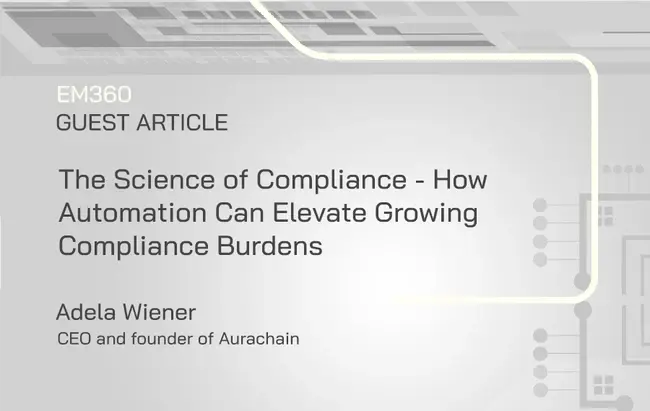
This article was written by Adela Wiener, CEO at Aurachain
Companies across the board are embracing digital transformation, whether it’s through digitizing customer interactions, internal business processes or even adjusting business models to take advantage of new technology. However, these sorts of changes don’t come without their challenges. Keeping on top of regulation and compliance can cause major roadblocks to digital transformation success and inflict unnecessary stress to the staff leading these projects - with teams often finding themselves forced to adjust their processes within challenging timelines.
Why invest in automation?
There’s good reason as to why an increasing number of businesses are investing in automation tools. Not only do they speed up processes and create more efficient workflows, they also reduce the risk of human error, cut costs and free up talent for more important work.
When applied correctly, these tools can reduce many of the manual and labor-intensive elements of compliance-related work, leaving governance leaders free to pursue more strategic tasks. For example, if someone in banking were to take an hour to make a risk decision, chances are that 95% of that effort would be spent going through a myriad of systems to collect information about the client or the transaction, doing manual checks on matching risk criteria, generating case documents, deliberating, and executing escalation paths and more. While roughly five percent of the time would be spent on the high value business decision. It’s an unsustainable ratio that gets worse every time new compliance rules are introduced, leading to more manual controls to accommodate each new regulation.
To make matters worse, compliance processes are often so convoluted that is difficult to understand where valuable and non-valuable activities are. Yet, this is not only about streamlining costs, reducing effort, and freeing up time. It’s also about the customer and how their experience with the bank is directly impacted by compliance activities that are tied to most of the transactions executed on their behalf. Loans, transfers, annual compliance reviews, even the process of opening an account, are all deeply threaded in compliance activity. And this activity needs to happen in a way that isn’t cumbersome, overly ominous and time consuming for the client, or the client may choose to take their business elsewhere.
Using automation to achieve compliance success
So much of today’s compliance activity can be streamlined and accelerated by automation. And most of this can be achieved when a company takes a holistic approach to the automation of compliance workflows. CEOs should be investing scalable technology that is easy integrate with existing systems and databases. Implementing tools that collect data from multiple sources, automate screening of cases data against multidimensional business rules, automate document generation and automatically execute escalation and review processes.
And from here applying them to repetitive process areas such as client onboarding, negative news and PEP reviews, transfers, loans and more. All can benefit greatly from investment in automation – freeing up both time and resource. Furthermore, potentially high-risk compliance processes can see a reduced risk through automation, simply because you are removing human error from the equation.
The value of automation within compliance even extends to audits, where the last thing you want is to be scrambling for your paper trail of activity. By automating compliance activity case data can be comprehensively tracked, traced and monitored every step of the way. It’s near enough impossible to gain 100% accuracy doing this manually, whereas automation tools will save each action into an activity log, giving you immediate access to your audit trail.
Challenges of automation
In some instances, however, automation can bring its own challenges. Many automation tools can be complex, and costly to implement and maintain, requiring regular input and monitoring from developers. Something that can be challenging at a time in which enterprises are facing a shortage of developers and associated skills. Development teams end up overstretched and working to increasingly tight deadlines. This can cause the team to become cut off from the rest of the business as complex automation tools cause communication barriers, stunting cross-team collaboration.
The platforms in which many of these processes are carried out can change and often there isn’t flexibility built into the software to accommodate these changes. On top of this, when new regulations come into place – even ones that only require a minor change to an application – this could mean months of work for the developer.
More so, it’s important to understand that automation tools are not the same; in many cases solving specific problems well, but far from a silver bullet that will safeguard all compliance challenges. For example, using an AI solution to decide on an insurance premium is essentially a good idea. But deciding on a premium is just one element of a much larger insurance underwriting journey, implying the need for tools that also cover holistic operational process flows.
Using low-code to power transformation
While automation of the compliance function presents tremendous new opportunities, we also know it comes with a central and unique challenge. That being the dynamic nature of regulation and what it implies in an automation journey. Otherwise stated, a constantly evolving regulatory landscape creates the need for a nimbler type of automation and re-automation. The type that permits agile, on-the-fly changes to accommodate alterations to automated processes in what are sometimes very tight timelines. Because of this, it is crucial to think about the long term and prepare in advance. It’s all about recognising that regulation will dictate change and therefore, putting the tools in place to accommodate that change with minimal effort and in fast timeframes.
There is a solution to these challenges, one that is simpler than you may think. And that is low-code. This technology provides a practical and collaborative solution to the demands on today’s workflows, helping organisations achieve an unprecedented speed of digitalisation, as it enables the creation and development of process applications with reduced coding. This means business owners, business analysts and tech teams who are heavily involved in implementing new regulatory compliance solutions, can work more effectively with IT to achieve the required changes effectively and on time. The traditional code-writing approach is replaced with intuitive visual configuration capabilities, comprising drag and drop user interfaces to add different types of elements, such as connection to databases, to other software applications or logic elements, and even blockchain implementations. The reduction in code requirements opens the door for collaboration from key personnel across workforces – from subject matter experts and business analysts to professional developers and IT specialists – who are all able contribute their expertise directly to the app creation process, resulting in significant gains in operational efficiency with no governance issues. This makes complex automation easy and accessible, in a highly streamlined and comprehensive workflow.
Wrap up
All enterprises can do is try to plan for the future – one that isn’t always certain. Investing in automation tools can reduce many of the manual and labor intensive elements of compliance-related work, leaving governance leaders free to pursue more strategic tasks. However, these functionalities need to be accessible and flexible in order to adapt to future changes. Low-code is the best way of bringing together your automation goals, encouraging cross-team collaboration and offering the flexibility that accommodates change.















Comments ( 0 )